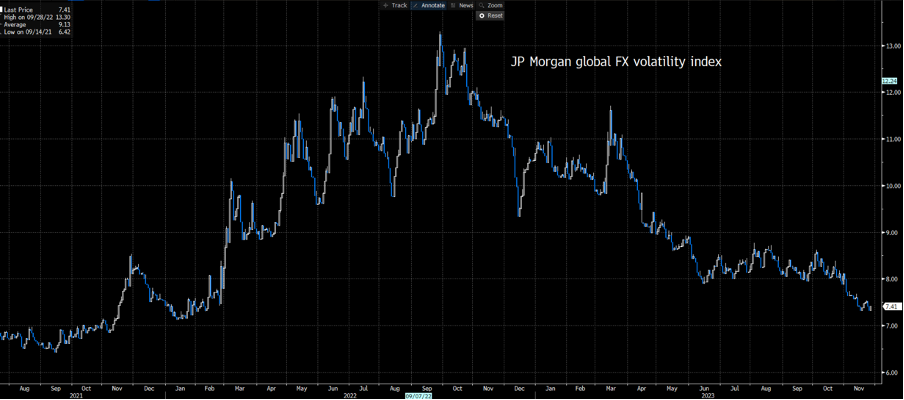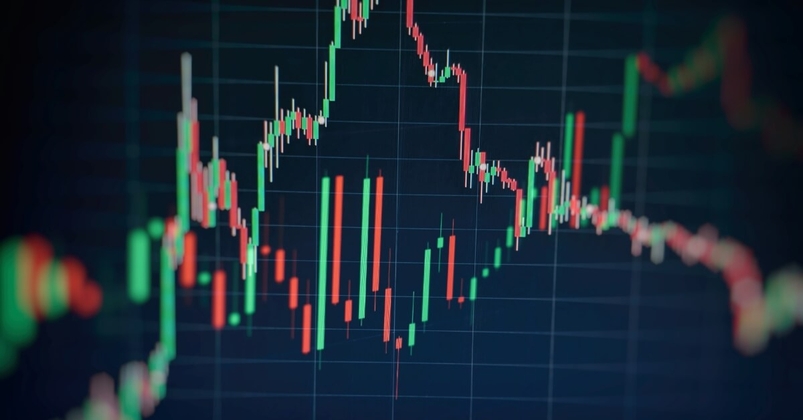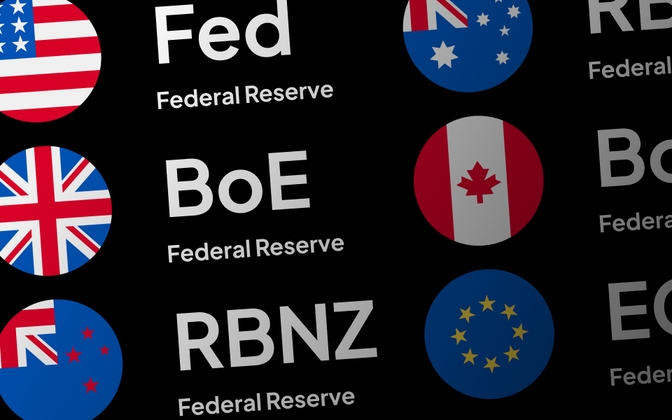Analysis
As we see in the JP Morgan global FX volatility index, this measure of vol sits at the lowest levels since February 2022.

There are several reasons behind this:
- US economic resilience – Market participants have closed US recession bets and moved to price a strong consensus ‘soft landing’ scenario in the US.
- Swaps markets price ‘adjustment rate cuts’ in 2024 in most G10 and EM countries, with the Fed moving away from a restrictive policy setting to a more neutral stance.
- The PBoC aggressively pursued a policy of predictable ranges, and low vol in CNY, fixing the currency almost every day through August and September at significantly stronger levels than what was implied.
- The BoJ/MoF threatened to intervene to curb JPY's weakness and traders saw this threat as credible. The BoJ also vigorously maintained a dovish bias which frustrated market players positioned for tighter policy.
- EURUSD failing to follow through on big trends – on the year we’ve seen the high-low range at a meagre 828 pips, the second lowest range on record.
_per_year.png)
Clearly, when you have the two big central Asian banks actively suppressing FX vol, it's no surprise to see hedge funds aligning their strategies and selling volatility.
Low vol can create winners and opportunities, and there have been some incredible opportunities within this market environment, most notably in LATAM FX.
Had you told me in December 2022 the Fed would hike to 5.33% and US 10-year real rates would get to 2.5%, I’d have expected sustained and elevated cross-asset vol. Add in an underwhelming economic rebound in China post Covid re-opening, with solvency concerns around China’s property developers and primary housing sales falling 30% yoy, and while a number of LATAM central banks commencing an easing cycle, and one could expect LATAM FX to have struggled.
This couldn’t have been further from the truth, and on a total return basis (the spot move + carry interest) the Colombian peso has gained an incredible +36% YTD, the Mexican peso +27%, the Brazilian real +20% and the Chilean peso +6.7%. Saying that if you’d told me GBPUSD would gain 9.2% by December 2023 I would have not believed you either.
Looking ahead to 2024
I guess the first consideration is whether any of the factors mentioned above change significantly. If they don’t then it’s hard to see a marked lift in volatility.
Still for the risk manager, and for those looking at factors which could dramatically shape our trading environment, then I would list the possibilities that could see higher volatility as follows:
- The market questions the US soft landing thesis and prices a genuine belief of a US recession, with risks the unemployment rate pushes above 5% – should the market feel the Fed accelerate the need for front-loaded rate cuts then the USD would rally and high beta FX and carry currencies would find more aggressive selling.
- US inflation proves to be sticky, and fails to move towards target, while growth falls well below potential. The Fed leave rates on hold throughout 2024, frustrating a market expecting 3-4 cuts in 2024.
- Central banks alter their guidance and guide to incoming rate cuts, but the expected pace of cuts and the starting dates are priced differently across G10 and EM economies – we get increased dispersion in expected central bank policy settings.
- China fails to contain its property sector and we see solvency concerns increase significantly, with the flow-on effect into weaker household consumption.
- Conversely, in the backdrop of a slowing global economy, China’s economy outperforms, but the PBoC not only tolerate higher vol but allows the CNY to appreciate, as FDI and international capital move into China to capture the opportunity.
- A geopolitical tail event impacts – we continue to watch developments in the Middle East and Ukraine.
Traders need to adapt to their market environment. Changes in vol need to be accounted in the degree of risk we take on and our position sizing. Vol can create emotional attachment to markets that needs to be accounted for, but it can create increased opportunity. I feel 2024 will be an eventful year in the FX markets, but one thing is clear; expect and plan for the unexpected.
Bring on the vol!
Related articles
The material provided here has not been prepared in accordance with legal requirements designed to promote the independence of investment research and as such is considered to be a marketing communication. Whilst it is not subject to any prohibition on dealing ahead of the dissemination of investment research we will not seek to take any advantage before providing it to our clients.
Pepperstone doesn’t represent that the material provided here is accurate, current or complete, and therefore shouldn’t be relied upon as such. The information, whether from a third party or not, isn’t to be considered as a recommendation; or an offer to buy or sell; or the solicitation of an offer to buy or sell any security, financial product or instrument; or to participate in any particular trading strategy. It does not take into account readers’ financial situation or investment objectives. We advise any readers of this content to seek their own advice. Without the approval of Pepperstone, reproduction or redistribution of this information isn’t permitted.


